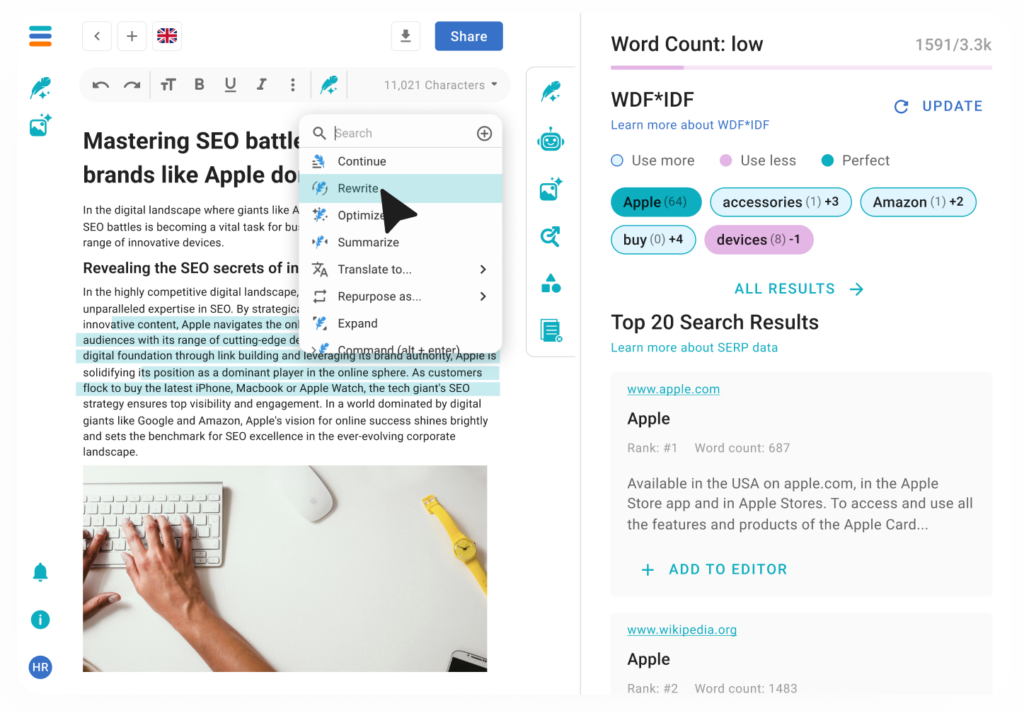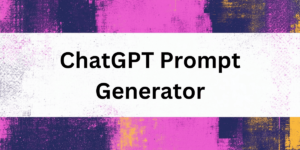Free AI Rewording Tool
How to use the neuroflash Rewording Tool


Paste in text
Paste the text you want to rewrite into the text field. If necessary, you can select the desired writing style (e.g. serious or casual), length or language.
Rewrite text
Click on the “Rewrite” button and the rewording tool creates a rewritten text in seconds. Depending on the input, the text may differ in length or tonality.
Edit text
Read through the rewritten text and adapt it according to your wishes. You can add content, reword or remove unwanted parts or simply generate a new rewritten text.
Rewording Tool: What Is It and How Does Work
🏆 Use Germany's leading AI content software
Generate on-brand AI texts and images for free every month! Including AI chatbot, 100+ prompt templates and more.
Table of contents
Digital technologies have reshaped the demand for high-quality, original content. Whether you’re a student, writer, marketer, or business professional, the ability to effectively communicate ideas is crucial. However, rewriting text manually can be time-consuming and challenging, especially when aiming to maintain originality and clarity. This is where rewording tools come into play.
Key Takeaways: Rewording Tools
- Rewording tools, powered by AI and NLP, facilitate efficient text reformulation while preserving core meaning.
- Functionality encompasses synonym replacement, sentence restructuring, and grammar correction, with advanced tools offering multiple rewriting modes.
- Key benefits include enhanced time efficiency, improved text clarity, plagiarism avoidance, and SEO optimization.
- Effective utilization necessitates understanding tool limitations, employing them as aids rather than replacements, and rigorous human review.
- Ethical considerations, such as transparency and academic integrity, are paramount when using rewording tools.
- Future advancements promise enhanced contextual understanding, multilingual support, and personalized writing assistance.
What Is a Rewording Tool?
A rewording tool is a type of software or online service that automatically rewrites or rephrases text while preserving its original meaning. A free rewording tool can be particularly beneficial for students and content creators, as it helps generate fresh content by replacing words, altering sentence structures, and sometimes even improving clarity and readability.
Rewording tools are widely used in various fields, including academic writing, blogging, content creation, and professional communications. They serve as a quick and efficient way to avoid plagiarism, enhance readability, and optimize content for SEO.

How It Works
Rewording tools utilize Natural Language Processing (NLP) and artificial intelligence (AI) to analyze and rewrite text intelligently. These tools can reword sentences and reword text to improve readability and uniqueness. Here’s a step-by-step look at how most rewording tools function:
- Input Text: Users paste or upload the text that needs to be reworded into the input box. The process can be completed with just a few clicks.
- Analysis: The tool scans the text to understand the meaning, structure, and context.
- Rewriting Process:
- Identifies synonyms and alternative phrases.
- Reconstructs sentences while maintaining logical flow.
- Adjusts grammar and punctuation as needed.
- Output Generation: The revised version of the text is presented, often with options for further customization.
Some advanced rewording tools use AI-powered deep learning models, like GPT-based technologies, to improve context awareness and generate more natural-sounding text.
Example:
- Original Text: “Technology is advancing rapidly, and businesses must adapt to stay competitive.”
- Reworded Text: “As technology evolves quickly, companies need to adjust to remain competitive.”
Key Features and Modes
Different rewording tools offer various features to enhance usability and effectiveness. Here are some of the most common features:
1. Synonym Replacement
Replaces words with contextually appropriate synonyms to make the text unique. Example:
- “happy” → “joyful”
- “important” → “crucial”
2. Sentence Restructuring
Alters sentence structure without changing the meaning. Example:
- Before: “She decided to buy a new laptop because her old one was too slow.”
- After: “Because her old laptop was too slow, she decided to purchase a new one.”
3. Grammar and Spelling Correction
Many tools integrate grammar checking to enhance readability and accuracy. However, while these tools can correct grammar, users should still review the text to ensure no grammatical errors are introduced.
4. Multiple Rewriting Modes
Some tools, like the reword tool, provide different modes based on user needs, such as:
- Standard Mode (basic rewording)
- Fluency Mode (improves readability)
- Creative Mode (enhances uniqueness)
- Formal Mode (refines professional tone)
5. Bulk Processing
Allows users to rewrite large amounts of text at once, saving time for content creators and businesses.
6. Integration with Other Platforms & User Friendly Interface
Some advanced tools offer plugins for Google Docs, WordPress, and other content management systems (CMS) for seamless workflow.

Benefits of Using a Rewording Tool
Using a rewording tool offers several advantages that can improve writing efficiency and effectiveness:
- Time Efficiency: Automates the rewriting process, reducing the time spent on manually rewording content. Additionally, a free AI rewording tool can automate the rewriting process efficiently.
- Improved Clarity: Enhances sentence structure, making text easier to read and understand. Rewording text can significantly improve clarity and engagement.
- Avoids Plagiarism: Generates unique content while maintaining the original message. Rewording sentences can help avoid plagiarism by ensuring the content remains original.
- Enhances Creativity: Provides alternative phrasing that can improve engagement and originality.
- Optimizes SEO: Helps in content optimization by offering diverse wording while keeping keywords relevant.
- Reduces Writer’s Block: Offers new ways to phrase ideas, making it easier to start writing.
Importance of Rewording Tools in Different Use Cases
Rewording tools play a vital role in various professional and creative fields. Here’s how they contribute to different industries:
1. Marketing and SEO
- Helps create multiple versions of ad copies and promotional content. A paraphrasing tool can assist in generating multiple versions of ad copies, ensuring variety and avoiding repetition.
- Improves keyword optimization without keyword stuffing.
- Enables A/B testing by providing alternative phrasing.
2. Business Communication
- Assists in refining emails, reports, and presentations.
- Enhances professionalism and clarity in corporate communication.
- Helps non-native English speakers articulate their messages effectively.
3. Academic Writing & Research
- Aids in paraphrasing sources to avoid plagiarism. It is also important to use a plagiarism detection tool to ensure originality.
- Improves clarity in research papers and assignments.
- Ensures that complex ideas are rewritten in simpler terms.
4. Content Creation & Blogging
- Speeds up the writing process by offering alternative phrasings.
- Helps bloggers create fresh, engaging, and plagiarism-free content.
- Improves readability and engagement for a diverse audience.
5. Social Media Management
- Assists in rephrasing posts for different platforms while keeping the core message intact.
- Helps generate multiple captions and taglines quickly.
- Enhances engagement with varied content styles.
6. Legal & Technical Writing & Plagiarism Detection Tool
- Simplifies complex terminology for better comprehension.
- Ensures clarity while maintaining legal or technical accuracy.
- Helps break down jargon-heavy documents into reader-friendly content.

Practical Guidance: Best Practices for Using Rewording Tools
Rewording tools, also known as paraphrasing tools, can be helpful for various tasks, from generating content variations to understanding complex texts. However, relying on them without careful consideration can lead to problems. Here’s practical guidance and best practices for using them effectively:
1. Understand the Limitations:
- Not a Substitute for Original Thought: Rewording tools are designed to restructure existing text, not to create original ideas. They can’t replace your critical thinking and writing skills.
- Potential for Inaccuracy: These tools may misinterpret nuances, resulting in awkward phrasing, factual errors, or even plagiarism if not used carefully.
- Lack of Contextual Understanding: They often struggle with complex or specialized topics, where subtle contextual differences can significantly alter meaning.
- Over-reliance hinders skill development: If you become too reliant on these tools, your own writing and comprehension skills will deteriorate.
2. Use Them as a Tool, Not a Crutch:
- For Inspiration and Idea Generation: Use them to explore different ways of phrasing a sentence or paragraph. They can provide alternative structures and vocabulary, which can spark your creativity.
- To Understand Complex Texts: If you’re struggling with a dense or technical passage, a rewording tool can offer a simpler version, helping you grasp the core concepts.
- For Generating Variations: If you need multiple versions of a piece of content (e.g., for social media posts or A/B testing), rewording tools can provide a starting point.
- To overcome writer’s block: Sometimes seeing a sentence written in a different way can help you overcome that stuck feeling.
3. Best Practices for Effective Use:
- Always Review and Edit: Never submit or publish text generated by a rewording tool without thorough editing. Check for accuracy, clarity, and natural flow.
- Verify Factual Accuracy: Especially with technical or factual content, double-check that the rewritten version maintains the original meaning and accuracy.
- Focus on Meaning, Not Just Words: Pay attention to the overall message and ensure that the rewritten text conveys the intended meaning.
- Use Multiple Tools (If Necessary): If you’re not satisfied with the results from one tool, try another. Different tools have different algorithms and strengths.
- Check for Plagiarism: Even if you’ve edited the text, use a plagiarism checker to ensure that the rewritten version is original. Some tools can create text that is too close to the original.
- Use Reputable Tools: Stick to well-known and reliable rewording tools. Free tools are not always the best choice.
- Combine with Human Input: The best results come from combining the output of rewording tools with your own writing and editing skills.
- Understand the Terms of Service: Be aware of the terms of service of any tool you use, particularly regarding copyright and data privacy.
- Use for specific tasks: Use them for short paragraphs or sentences, rather than long documents, to minimize errors.
- Learn to identify common errors: Over time you will learn to spot common errors generated by these tools, such as awkward phrasing, or incorrect word substitutions.
4. Ethical Considerations:
- Transparency: If you’re using rewording tools for professional purposes, be transparent about it, especially when working with clients or collaborators.
- Academic Integrity: In academic settings, using rewording tools without proper attribution is considered plagiarism. Understand your institution’s policies and guidelines.
- Avoid Misrepresentation: Don’t use rewording tools to misrepresent someone else’s work or ideas as your own.
By following these best practices, you can leverage the benefits of rewording tools while minimizing the risks. Remember that they are a tool to assist you, not to replace your own abilities.
Use Cases and Industry Applications of Rewording Tools
Rewording tools have a wide array of real-world applications across multiple industries:
Academic Writing:
Students and researchers use rewording tools to paraphrase complex texts, ensuring clarity and originality in essays and research papers. For instance, a student might use these tools to simplify dense academic language while retaining the core ideas, ultimately helping avoid plagiarism while learning new vocabulary. A user-friendly interface makes these tools accessible for students and researchers, allowing them to easily copy and paste text without any hassle.
Content Marketing and SEO Optimization
Marketers deploy rewording tools to generate fresh, engaging content for blogs, social media, and web pages. By automatically rephrasing and diversifying language, these tools improve SEO performance—optimizing keyword density without sacrificing readability.
Case Example: A digital marketing team reported that using an AI rewording tool led to a 20% increase in organic traffic, as the refreshed content resonated better with their target audience.

Business Communication
Professionals use rewording tools to refine emails, proposals, and reports. These tools ensure that communications remain clear and professional, adapting content to suit various business contexts.
Language Learning
Non-native English speakers benefit from these tools by discovering alternative phrasings and expanding their vocabulary, which helps in understanding nuances and enhancing overall language proficiency.
For bloggers and content creators, an AI-powered online tool is an excellent resource for generating new content based on existing ideas. It saves time while still maintaining the quality and relevance of the message. For example:
Limitations and Challenges
Despite their benefits, rewording tools are not without challenges:
- Loss of Original Tone: Automated tools might sometimes standardize your language too much, diluting your unique voice. To counter this, it’s important to always review the output and make manual adjustments where necessary. Additionally, rewriting tools can sometimes standardize language too much.
- Contextual Misinterpretation: AI may occasionally misinterpret the context, especially with idiomatic expressions or nuanced language, leading to output that doesn’t accurately reflect the intended meaning. Cross-checking with the original text is essential.
- Over-Reliance on Automation: Relying too heavily on these tools can stifle your own creative development and reduce your engagement with the writing process. Balancing AI assistance with personal input ensures that your writing remains authentic and skillful. Moreover, retaining the same ideas while rewording can still be considered plagiarism.
Strategies to Mitigate These Issues:
- Human Editing: Always incorporate a human review step to maintain your style and ensure contextual accuracy.
- Customization: Use the custom modes and fine-tune settings to better align the output with your intended tone.
- Regular Feedback: Provide feedback to the tool (where supported) so that its suggestions can improve over time.
Future Trends
Looking ahead, rewording tools are poised to become even more sophisticated and integrated into our writing workflows:
1. Enhanced Integration:
Future tools may seamlessly integrate with popular word processors (like Microsoft Word and Google Docs), content management systems, and even collaborative platforms, making the rewording process a natural part of daily writing tasks.
2. Improved Contextual Understanding:
As AI models continue to evolve, we can expect greater accuracy in interpreting context, meaning, and tone, which will help reduce errors and maintain the original voice more effectively.
3. Multilingual Support:
While many current tools support a limited number of languages, future developments could offer robust multilingual capabilities, catering to a global audience and supporting a wider array of linguistic nuances.
4. Greater Personalization:
Advances in machine learning could lead to tools that learn from your writing style over time, offering suggestions that are uniquely tailored to your voice. Imagine a rewording tool that adapts not just to a genre or tone, but to your individual writing patterns.
5. Greater Personalization:
Advances in machine learning could lead to tools that learn from your writing style over time, offering suggestions that are uniquely tailored to your voice. Imagine a rewording tool that adapts not just to a genre or tone, but to your individual writing patterns.
Conclusion
Rewording tools are powerful assets for writers, students, marketers, and professionals looking to optimize their content. By leveraging AI and NLP, these tools offer efficient solutions for rewriting text while preserving meaning. However, the best results come from combining automated assistance with human judgment. By following best practices, users can maximize the benefits of rewording tools for content creation, academic writing, business communication, and beyond.
Whether you’re aiming to enhance readability, improve SEO, or avoid plagiarism, a well-chosen rewording tool can make your writing process smoother and more effective. Happy writing!
FAQ

Can Turnitin detect rewording?
Turnitin can detect rewording through its sophisticated algorithms that compare submitted text with a vast database of academic content. It can identify similarities in phrasing and sentence structure, even if the words have been changed.
Does Grammarly have a rewording tool?
Yes, Grammarly offers a rewording tool called the “Rewrite” feature. This tool can help users rephrase sentences to improve clarity and style, making it a useful tool for writers looking to enhance their writing.
What is the AI that rewords text?
One example of AI that rewords text is the GPT-4 (Generative Pre-trained Transformer 4) model developed by OpenAI. GPT-4 is a powerful language model that can generate human-like text and is often used for tasks like rewording, summarizing, and generating content.
Use now for free - without sign-up

Creating content has never been easier -
Get started for free!
Keine Kreditkarte notwendig.








